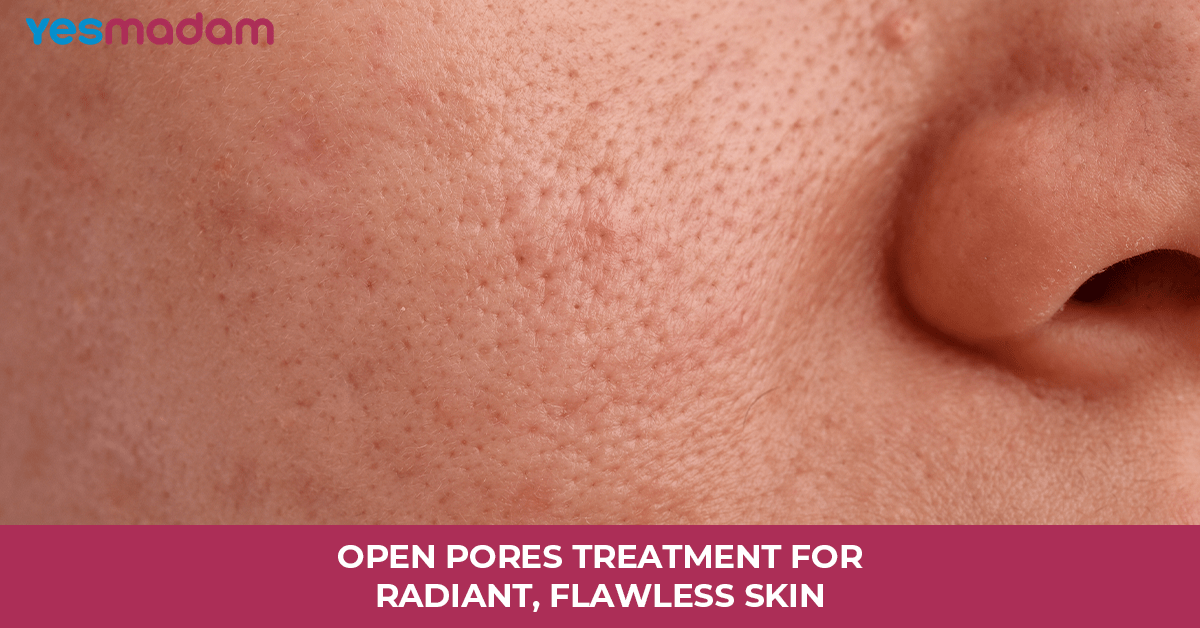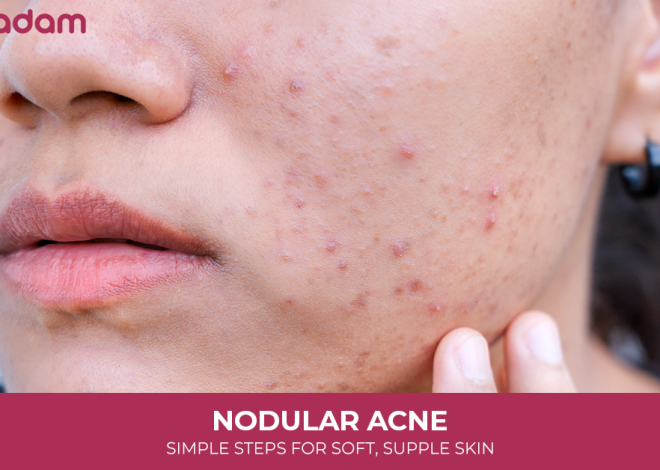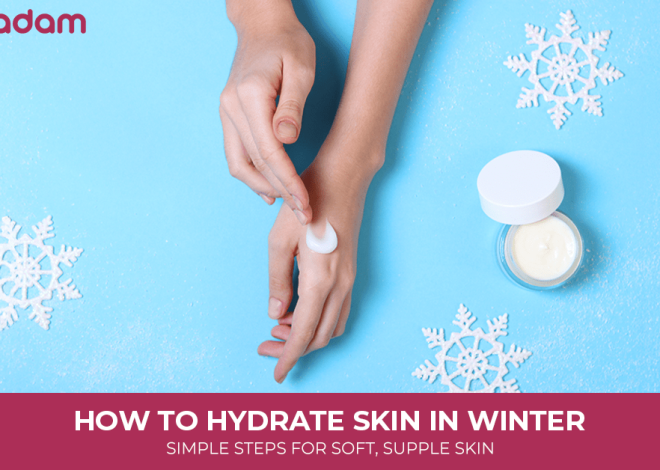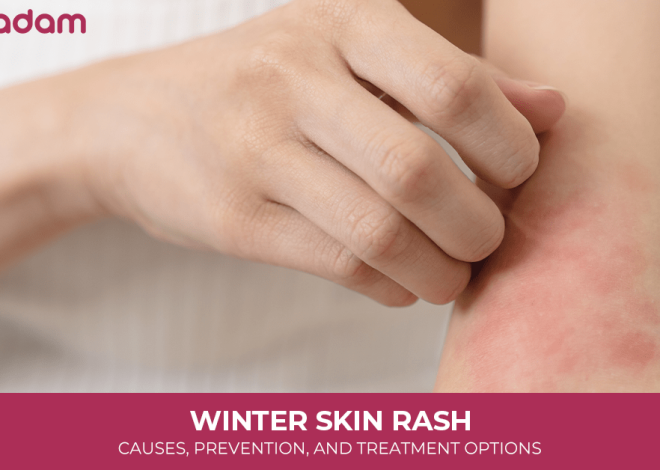
Open Pores Treatment for Radiant, Flawless Skin
If you’ve ever struggled with visible pores, you know how frustrating it can be to find a reliable open pores treatment. Enlarged pores often make the skin look uneven, oily, and textured. They can also make makeup application difficult, leading to a lack of confidence in your overall appearance. The good news is that with the right skincare routine, professional procedures, and lifestyle changes, you can manage and reduce the appearance of open pores effectively.
In this blog, we’ll help you explore everything you need to know, from causes and prevention to the best treatment for open pores on the face, including advanced dermatological solutions and natural remedies.
So Let’s Get Started…
Table of Contents
What are Open Pores?

Open pores are tiny openings on the surface of the skin that serve an important function; they allow sebum (the skin’s natural oil) and sweat to pass through. Sebum helps maintain skin hydration and provides a protective barrier, while sweat plays a role in temperature regulation.
Although pores are an essential part of skin anatomy, they can sometimes appear larger and more noticeable. This happens when oil production increases, when pores get clogged with dead skin cells or debris, or when the skin loses firmness. Enlarged pores are not a medical concern, but they are often considered a cosmetic issue because they can make the skin look uneven or textured.
Common Causes of Enlarged Pores
Several underlying factors contribute to the appearance of open or enlarged pores. Understanding these can help in managing and minimizing them:
1. Excessive Sebum Production
- People with oily or combination skin often experience more visible pores.
- When sebaceous glands produce excess oil, it mixes with dead skin cells and dirt, stretching the pore and making it appear larger.
- This is also why enlarged pores are common in areas like the T-zone (forehead, nose, chin), where oil glands are most active.
2. Aging and Loss of Skin Elasticity
- As we age, the skin naturally loses collagen and elastin — the proteins responsible for keeping it firm and supple.
- With less structural support, pores don’t “bounce back” as easily and appear more open.
- Fine lines, sagging, and enlarged pores often go hand-in-hand with mature skin.
3. Genetics
- Pore size can be hereditary.
- If your parents have visible pores or oily skin, you are more likely to experience the same.
- While you cannot change your genetics, targeted skincare can minimize their appearance.
4. Sun Damage
- Prolonged exposure to UV rays damages collagen and elastin fibers in the skin.
- This breakdown weakens the skin’s support system, causing pores to stretch.
- Sun damage also thickens the outer layer of skin (stratum corneum), which can clog pores and make them more noticeable.
5. Improper Skincare Habits
- Using overly harsh cleansers strips the skin of natural oils, causing it to overcompensate by producing more sebum.
- Skipping proper cleansing allows dirt, oil, and dead skin cells to accumulate, leading to clogged and enlarged pores.
- Neglecting sunscreen accelerates sun damage, worsening pore visibility over time.
How to Reduce Open Pores on Your Face?

Open pores won’t vanish overnight, but with a little consistency and the right routine, you can definitely make them look less visible. Here’s what really helps:
Cleanse Thoroughly
Keep your skin clean every day. Go for a gentle cleanser that removes dirt, oil, and impurities without being harsh. Salicylic acid cleansers are especially great; they get deep into pores and clear them out. At night, double cleansing (to remove sunscreen and makeup properly) makes a huge difference.
Don’t Skip Toner
Toner is often overlooked, but it can really refine your skin. A good toner sweeps away any leftover dirt, balances oil, and makes pores look smaller. You can pick one with ingredients like witch hazel or niacinamide to tighten and regulate oil, or a hydrating one with hyaluronic acid to smooth and plump your skin.
Exfoliate Weekly
Exfoliation is key. Once or twice a week, use a gentle scrub or a chemical exfoliant like AHAs or BHAs to remove dead skin cells and buildup. This keeps pores clear and prevents them from looking stretched. Just don’t overdo it—too much exfoliation can irritate the skin and make pores worse.
Treat, Hydrate & Protect
Even oily skin needs hydration. A lightweight, non-comedogenic moisturizer will keep your skin balanced and stop it from producing extra oil. Add a serum with niacinamide, retinol, or vitamin C to improve skin texture and tighten pores over time. And don’t forget sunscreen, UV damage can make pores look larger, so SPF 30+ every day is non-negotiable.
Use Face Masks
Face masks are a nice bonus step. Clay masks with kaolin or bentonite help absorb excess oil and clear out impurities, leaving your skin tighter and fresher. If you like DIY, a fuller’s earth mask works well too.
Professional Treatments
If nothing seems to work, you can always explore professional options. Microdermabrasion gently buffs the skin to improve texture, while laser treatments boost collagen to tighten pores. These should always be done by a qualified dermatologist.
Open pores are completely normal, but with the right care, you can definitely minimize their appearance and keep your skin looking smooth and healthy. If you’ve tried everything and still feel stuck, it’s worth checking in with a dermatologist to rule out conditions like acne or rosacea.
Open Pores Treatment: Dermatologist-Approved Treatments for Enlarged Pores
Enlarged pores are a common skin concern that can make your complexion look uneven and textured. While they cannot be “erased” completely, the right dermatologist-approved treatments can significantly minimize their appearance and improve overall skin health.
1. Topical Retinoids
Retinoids increase cell turnover, unclog pores, and boost collagen production, helping skin look smoother and more refined.
2. Chemical Peels
Dermatologists often recommend peels with salicylic acid, glycolic acid, or lactic acid. These exfoliate dead skin cells, clear blockages, and tighten pores.
3. Laser & Light Therapies
Fractional lasers, IPL, and other advanced devices stimulate collagen production, reducing pore size over time while improving skin tone and texture.
4. Microneedling with Radiofrequency
This minimally invasive treatment uses fine needles and RF energy to remodel skin and shrink pore appearance.
5. Professional Extractions & Facials
Medical-grade facials, such as hydrafacials, deeply cleanse the skin and keep pores clear of excess oil and debris.
6. Proper Skincare Routine
Daily use of:
- Gentle cleansers (avoid harsh scrubbing)
- Niacinamide serums (controls oil & tightens pores)
- Oil-free, non-comedogenic moisturizers
- Broad-spectrum sunscreen (protects collagen and elasticity)
While enlarged pores cannot vanish completely, dermatologist-approved treatments, from retinoids to lasers can make them far less noticeable. Pairing professional procedures with a consistent skincare routine ensures smoother, healthier-looking skin.
Treatment for Open Pores on Face: Home Remedies for Open Pores

So, open pores are super common; they usually look bigger when your skin gets oily, clogged, or just loses some elasticity with age. The truth is, you can’t really “close” pores completely, but you can make them look smaller and keep your skin smoother.
Here are some easy, at-home things you can try:
- Ice cubes: Quick fix! Just rub a cube (wrapped in a thin cloth) over your face. It tightens up the pores for a while and gives you a fresh look.
- Apple cider vinegar: Works like a natural toner. Mix with water, dab it on, and it balances oil and shrinks pores.
- Aloe vera gel: Super soothing. Apply fresh gel directly, keeps skin hydrated and firm.
- Egg white mask: Yeah, it sounds messy, but it really works to tighten skin and reduce oil.
- Multani mitti (fuller’s earth): A classic! Mix with rose water, use as a mask once a week — pulls out excess oil and cleans pores.
- Green tea: Brew, cool, and swipe on like a toner. Antioxidants + oil control.
- Honey + lemon: Natural combo, honey moisturizes, lemon tightens. Just don’t leave it too long if you’ve got sensitive skin.
- Cucumber juice: Super refreshing, calms the skin and helps shrink pores.
And of course, little daily habits matter too: wash your face twice a day, exfoliate gently a couple of times a week, always take makeup off before bed, and never skip sunscreen. If pores + acne/scars are really bothering you, a dermatologist can go a step further with things like peels, laser, or retinol creams.
Open Pores Treatment for Oily Skin
People with oily skin are more prone to enlarged pores due to excess sebum. Specialized open pores treatment for oily skin focuses on oil control:
- Oil-Control Cleansers: Foaming cleansers with salicylic acid regulate oil.
- Clay Masks: Absorb excess sebum.
- Niacinamide Serums: Reduce oil production.
- Professional Oil-Control Peels: Balance sebum and refine pores.
Maintaining consistency with these treatments can dramatically improve pore appearance in oily skin.
Home Remedies for Open Pores: Pros and Cons
Home remedies can help manage the appearance of open pores, but they generally work more gradually compared to professional treatments. They are best used as a supportive part of your skincare routine, especially when professional options are not available.
| Pros | Cons |
| Natural and chemical-free | Results are usually subtle and take time to show |
| Cost-effective | May not suit all skin types, particularly sensitive skin |
| Convenient, ingredients often available at home | Some ingredients can cause irritation or allergic reactions |
Conclusion
Open pores may not disappear completely, but with the right open pores treatment, you can achieve smoother, healthier-looking skin. From daily skincare practices to advanced dermatologist procedures, there are plenty of options to explore. Whether you’re considering home remedies, open pores skin treatment, or even permanent treatment for open pores, consistency and professional guidance will ensure long-lasting results.
If you struggle with oily skin, don’t worry, specialized open pores treatment for oily skin can keep excess sebum under control. Ultimately, investing in the right open pores treatment for face is about enhancing skin health, boosting confidence, and maintaining radiant skin for the long run.
FAQs
1. Can open pores be completely closed?
No, pores cannot be closed entirely since they are part of skin anatomy. However, treatments can make them less visible and improve overall skin texture.
2. Is laser treatment safe for open pores?
Yes, when performed by a certified dermatologist, laser treatments are safe and effective for reducing pore size and improving skin elasticity.
3. How long do results from chemical peels last?
Results typically last a few weeks to months, depending on your skincare routine and lifestyle. Regular maintenance peels may be needed for lasting effects.
4. Which natural remedy works best for open pores?
Clay masks and aloe vera are among the most effective natural remedies as they help control oil, tighten pores, and soothe the skin.
5. Is there a permanent solution for open pores?
While there is no absolute permanent solution, advanced treatments like fractional lasers and microneedling with PRP can provide long-term improvements.
6. Can oily skin make pores worse?
Yes, oily skin produces more sebum, which can enlarge pores and make them more visible. Proper oil control is essential in managing pore size.
7. How often should I exfoliate if I have open pores?
Exfoliating 2–3 times a week with gentle acids like AHAs or BHAs is recommended. Over-exfoliation can irritate the skin and worsen pore visibility.
8. Are open pores linked to acne?
Yes, clogged pores filled with oil and dirt can lead to blackheads, whiteheads, and acne. Keeping pores clean reduces the risk of breakouts.
9. Can diet influence open pores?
Absolutely. Diets high in sugar and unhealthy fats can trigger excess oil production, leading to enlarged pores. A balanced diet supports healthier skin.
10. Do men and women need different open pores treatments?
The basic treatments are similar, but men may need stronger oil-control measures due to higher sebum production. Women may require hormone-related care if pores enlarge due to hormonal fluctuations.



